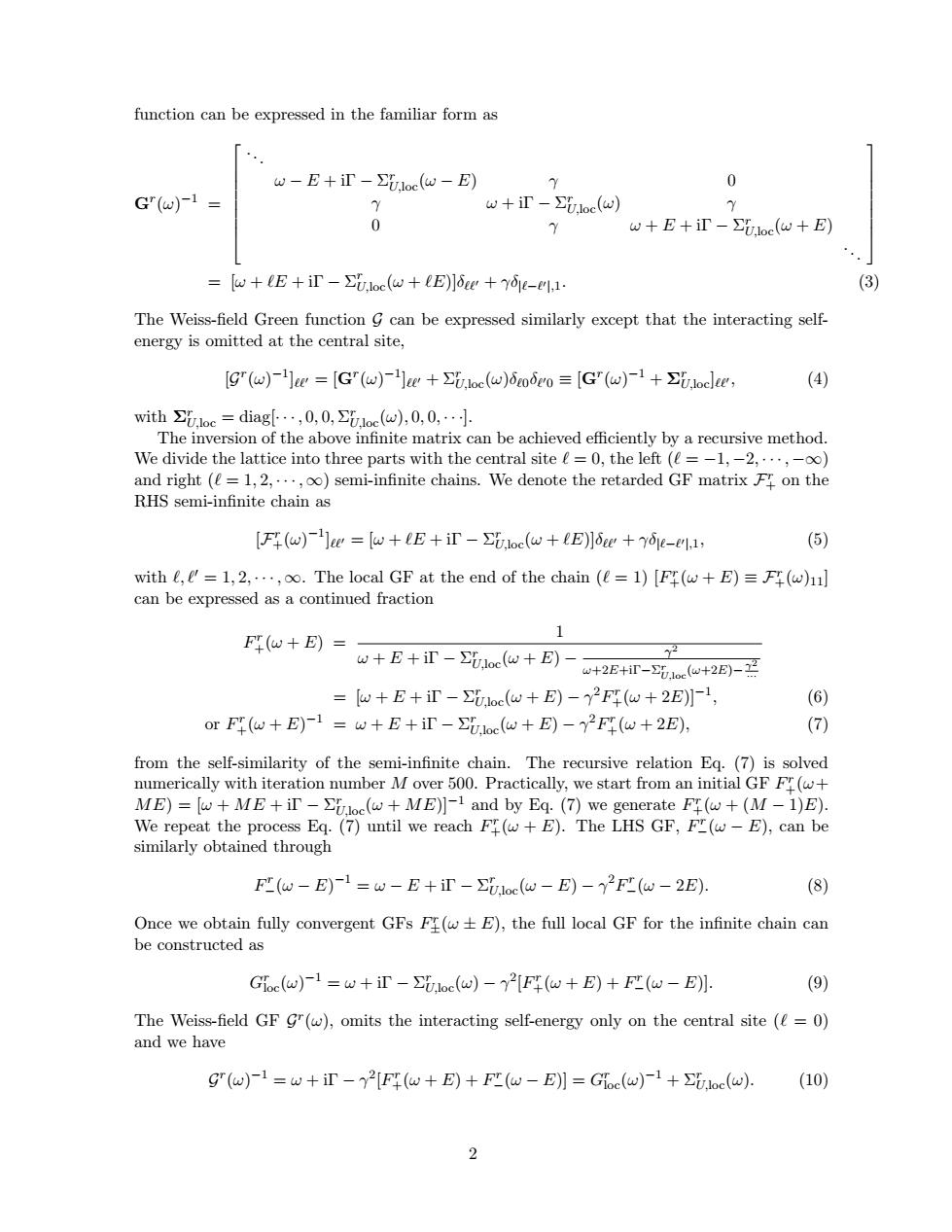正在加载图片...

function can be expressed in the familiar form as w-E+ir-光o(w-E) 0 Gr(w)-1= 0 w+ir-the刨 w+E+ir-o(+E) =w+eE+ir-EtLoe(w+lE)]6ue +youe-el1. 3 energy is omitted the central site, [g"(w)-I]u=[G"(w)-I]u+EUe(w)608o=[G"(w)-1+Uoelu, (4) with2%oe=diag…,0,0,boc(u),0,0,小 The inversion of the above infinite matrix can be achieved efficiently by a recursive method. We divide the lattice into three parts with the central site=0,the left(=-1,-2..) and right (=1,2,..,)semi-infinite chains.We denote the retarded GF matrixF on the RHS semi-infinite chain as [F()-lle=+E+i-oc(w+EEe+de-, (5) with t,=1,2,...,oo.The local GF at the end of the chain (1)[F(+E)F(w)] can be expressed as a continued fraction 1 F(w+E)= w+E+ir-EUloc(w+E)- w+2E+ir-EB.loe(w+2E)- kw+E+ir-Ei.loc(w+E)-7FI(w+2E)]-1, (6) or FI(w+E)-1=w+E+ir-EUloe(w+E)-7F(w+2E), (7) from the self-similarity of the semi-infinite chain.The recursive relation Eq.(7)is solved mumerically with iteration number M over 500.Practically,we start from an initial GFF(w+ ME)=w+ME +ir-Uloc(w+ME)]-and by Eq.(7)we generate F(w+(M-1)E). We repeat the process Eq.(7)until we reach F(w+E).The LHS GF,F(w-E),can be similarly obtained through F(w -E)1=w-E+ir-EUloc(w -E)-Y2F(w-2E) (⑧) Once we obtain fully convergent GFsFE),the full local GF for the infinite chain can be constructed as Gioc(w)=w+ir-Etloc(w)-[F4(w+E)+F(w-E)]. (9) g"(w)-1=w+ir-72[F(w+E)+F(w-E)]=Gloe(w)-1+Loe(w).(10) 2 function can be expressed in the familiar form as Gr (ω) −1 = . . . ω − E + iΓ − Σ r U,loc(ω − E) γ 0 γ ω + iΓ − Σ r U,loc(ω) γ 0 γ ω + E + iΓ − Σ r U,loc(ω + E) . . . = [ω + `E + iΓ − Σ r U,loc(ω + `E)]δ``0 + γδ|`−` 0 |,1 . (3) The Weiss-field Green function G can be expressed similarly except that the interacting selfenergy is omitted at the central site, [G r (ω) −1 ]``0 = [Gr (ω) −1 ]``0 + Σr U,loc(ω)δ`0δ` 00 ≡ [Gr (ω) −1 + Σr U,loc]``0, (4) with Σr U,loc = diag[· · · , 0, 0, Σ r U,loc(ω), 0, 0, · · ·]. The inversion of the above infinite matrix can be achieved efficiently by a recursive method. We divide the lattice into three parts with the central site ` = 0, the left (` = −1, −2, · · · , −∞) and right (` = 1, 2, · · · , ∞) semi-infinite chains. We denote the retarded GF matrix F r + on the RHS semi-infinite chain as [F r +(ω) −1 ]``0 = [ω + `E + iΓ − Σ r U,loc(ω + `E)]δ``0 + γδ|`−` 0 |,1 , (5) with `, `0 = 1, 2, · · · , ∞. The local GF at the end of the chain (` = 1) [F r +(ω + E) ≡ Fr +(ω)11] can be expressed as a continued fraction F r +(ω + E) = 1 ω + E + iΓ − Σr U,loc(ω + E) − γ 2 ω+2E+iΓ−Σr U,loc(ω+2E)− γ2 ··· = [ω + E + iΓ − Σ r U,loc(ω + E) − γ 2F r +(ω + 2E)]−1 , (6) or F r +(ω + E) −1 = ω + E + iΓ − Σ r U,loc(ω + E) − γ 2F r +(ω + 2E), (7) from the self-similarity of the semi-infinite chain. The recursive relation Eq. (7) is solved numerically with iteration number M over 500. Practically, we start from an initial GF F r +(ω+ ME) = [ω + ME + iΓ − Σ r U,loc(ω + ME)]−1 and by Eq. (7) we generate F r +(ω + (M − 1)E). We repeat the process Eq. (7) until we reach F r +(ω + E). The LHS GF, F r −(ω − E), can be similarly obtained through F r −(ω − E) −1 = ω − E + iΓ − Σ r U,loc(ω − E) − γ 2F r −(ω − 2E). (8) Once we obtain fully convergent GFs F r ±(ω ± E), the full local GF for the infinite chain can be constructed as G r loc(ω) −1 = ω + iΓ − Σ r U,loc(ω) − γ 2 [F r +(ω + E) + F r −(ω − E)]. (9) The Weiss-field GF G r (ω), omits the interacting self-energy only on the central site (` = 0) and we have G r (ω) −1 = ω + iΓ − γ 2 [F r +(ω + E) + F r −(ω − E)] = G r loc(ω) −1 + Σr U,loc(ω). (10) 2